Detailed response to the lecture by Etienne Vernaz
Response coordinated by Jean-François Mouhot, Director of A Rocha France, with the participation of the network of A Rocha Ambassadors. Special thanks for their contributions to Antoine Bret (Professor, University of Castilla La Mancha) and Thierry Dudok de Wit (Professor at the University of Orléans and the International Space Science Institute in Berne).
Preliminary note
On 30 October 2022 at the La Porte Ouverte church in Mulhouse, Etienne Vernaz gave a lecture in which he challenged the current scientific consensus on the age of the earth, the theory of evolution, the origin of humans and the seriousness of global warming.
The video of the operation was filmed and can be found on two videos : video 1 and video 2. We use the timing from video 1, below.
We have first written a general summary response (which we invite you to read first). But the purpose of this document is to demonstrate and provide a critical apparatus for what we have merely summarised in the summary document.
In the following sections, we will concentrate solely on the parts relating to climate change, although there’s a lot to be said for other points too (but we’ll leave that to others, like the “Science et Foi” site, which is also preparing a response).
Generally speaking, Etienne Vernaz mixes things that are true, things that are partly false and things that are completely wrong. Many of the arguments used by the speaker are a sort of ‘potpourri’ of arguments that have been used for many years by climate sceptics, and which have already been refuted many times; many are also taken from social networks where climate sceptic infoxes (false information or hoaxes) abound; a large number of these infoxes are regularly refuted by articles in Agence France Presse (which we invite you to consult) and on many other equivalent sites.
Methodology
1) First of all, we took a screenshot of the slides in the Powerpoint presentation that relate to our subject.
2) We have also transcribed verbatim part of the interview with Etienne Vernaz, which is at the very end of the video, after his lecture proper, and we have a few more comments to make.
Each time, we have added comments under the problematic parts of sentences or slides.
It should be noted that most of the articles to which we refer are in English. Almost all the world’s scientific publications are in English, which makes it difficult for those who do not read the language to find the truth. However, translation tools such as deepl.com or Google translate allow you to get a good idea of the content of an article even if you don’t read English.
We didn’t want to cover all of Etienne Vernaz’s speech, but only the most problematic parts in relation to the subject of global warming. The parts in italics are Etienne Vernaz’s verbatim comments.
1. Slides
20. What are we formatted by? (1:35:50)
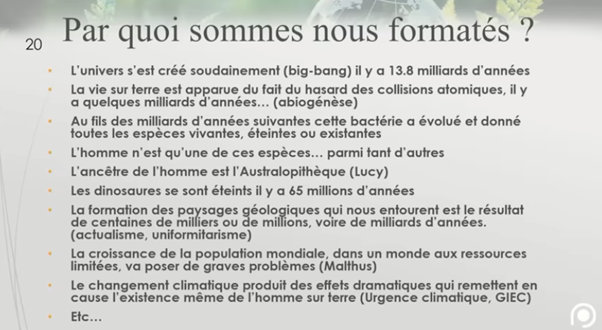
“Climate change is having dramatic effects that are calling into question the very existence of mankind on earth (climate emergency, IPCC)”.
The verb tense is wrong and does not correspond to what the IPCC is saying. The climate scientists are not saying, in the present tense, that climate change calls into question the very existence of man on earth. They are warning that climate change, if unchecked, if we continue to burn all the oil, gas and coal we can get our hands on, could cause global warming in the 21st century that would be catastrophic for mankind.
21. Strong intimidation in the name of science (1:37:25)
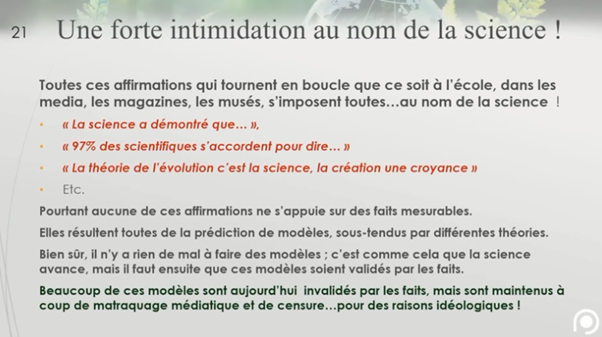
“Science has shown that 97% of scientists agree that [global warming is man-made]. “
This oft-quoted figure of 97% comes from two studies [Cook et al, 2013 and Cook et al, 2016]. Incidentally, its first and main author, John Cook, is a Christian, as he recently told The Guardian newspaper: “I am a Christian and I find myself strongly challenged by passages in the Bible like Amos 5 and Matthew 25 (…). I care about the same things that the God I believe in cares about – the plight of the poor and vulnerable”.
In the 2013 study, the authors combed through 11,944 publications relating to global warming to conclude that 97% of them recognised a link between global warming and anthropogenic effects. An independent article [Tol, 2016] criticised their method, without questioning the overwhelming majority of scientists who affirm the role of man. A more recent paper concludes, in part, “Among those with the highest level of expertise (independently confirmed climate experts who have each published more than 20 peer-reviewed papers on climate change between 2015 and 2019), there was 100% agreement that the Earth is warming primarily because of human activity.” (Myers et al, 2021)
“Honesty dictates that a model must be confronted with the facts, and we will go back to the model until we have an agreement between the model and the facts. And when it doesn’t work, we question our model” (1:38:10)
This is precisely what Etienne Vernaz does not do. He is careful not to present the arguments (of which there are many more than his own) that undermine his argument.
“Many of these models are now invalidated by the facts”.
It’s not true. Comparisons with past predictions and reality are entirely satisfactory. See this comparative study, for example. Even the multinational Exxon Mobil, which should not be suspected of being an environmentalist, predicted global warming as far back as 1982, according to this document (see graph below).
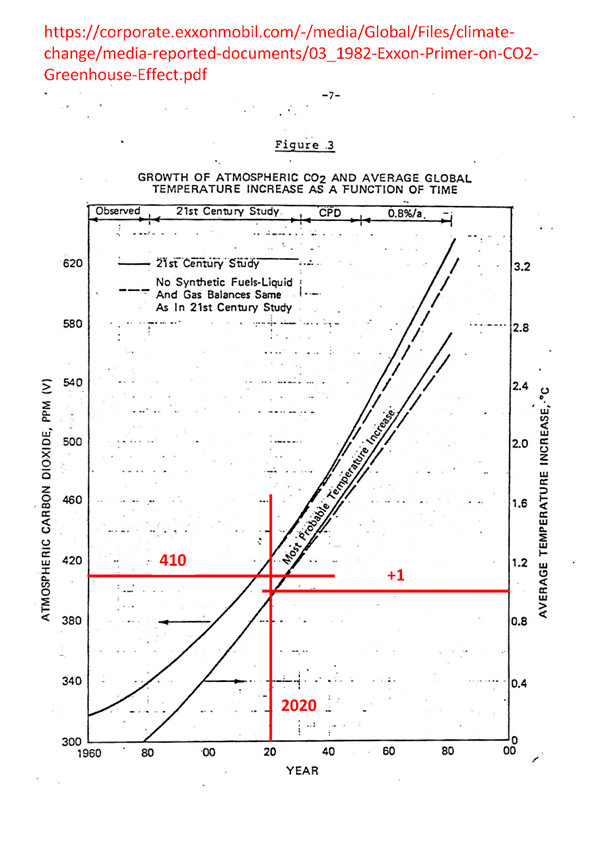
52. Melting ice pack (2:08:50)
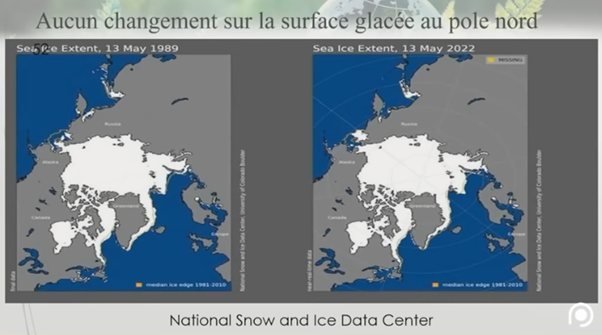
These two side-by-side images were taken from a recent Facebook post (as shown in this article, which dismantles the misleading mechanisms). The images come from the National Snow and Ice Data Center (NSIDC). They appear to show that the extent of the Arctic ice pack did not change between May 1989 and May 2022. However, the site of the same organisation also contains the curve below, for all the months of May since 1979,
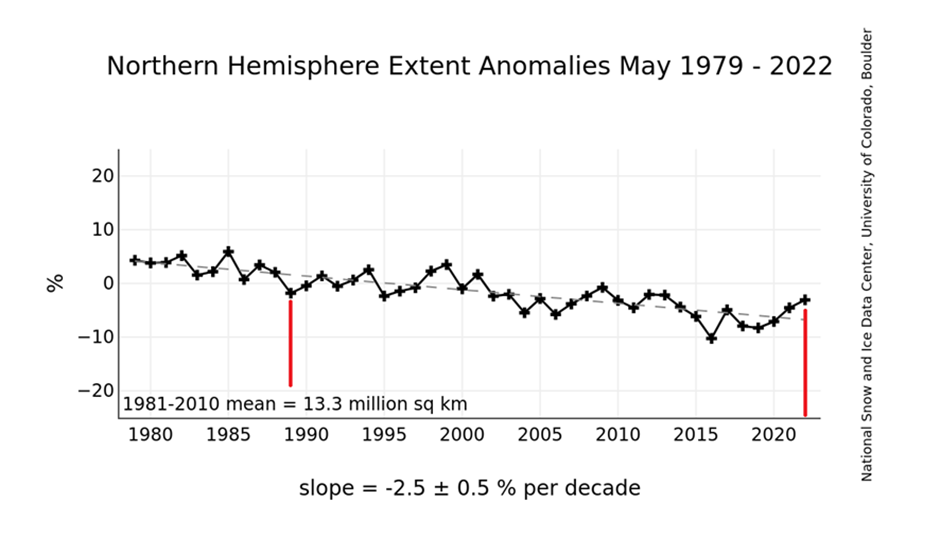
As you can see, it’s going down. So does the NSIDC support one thing and its opposite? The explanation is simple.
The photo compares May 1989, a particularly low year at that time, with May 2022, a particularly high year (the red lines have been added to indicate the data it has chosen). A judicious choice of 2 isolated values out of 43, to give the impression that the downward trend does not exist.
Now let’s play the same game. But let’s compare May 1985 and May 2016. The NSIDC data is as follows,
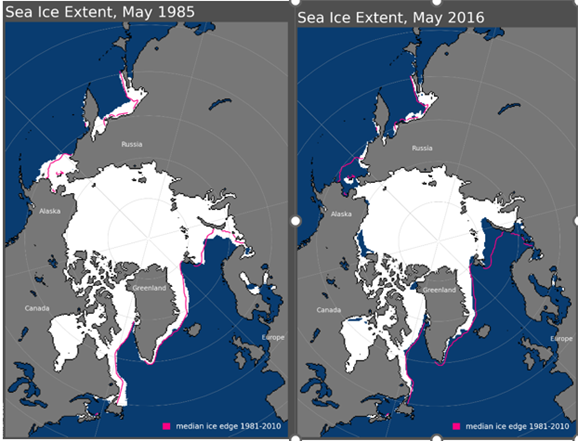
Here, we can clearly see a loss. But here again, the exercise is misleading because we chose May 1985, which was fairly high for the time, and May 2016, which was fairly low for the time. Only the curve for all the months of May since 1979 allows us to really appreciate the loss over the long term.
However, the loss is not enormous, even when we cheat as much as the people who put these photos together. Why not? Because May is the time of year when the Arctic ice is at its greatest extent. And this maximum extension is limited by the surrounding continents, as can be seen on the maps.
Instead of choosing the months of May, when the maximum extension is limited by the neighbouring landmasses, let’s choose the months of September, at the end of summer, when the extension is minimal and nothing limits it from below. The data is available on the NSIDC website and the curve is as follows,
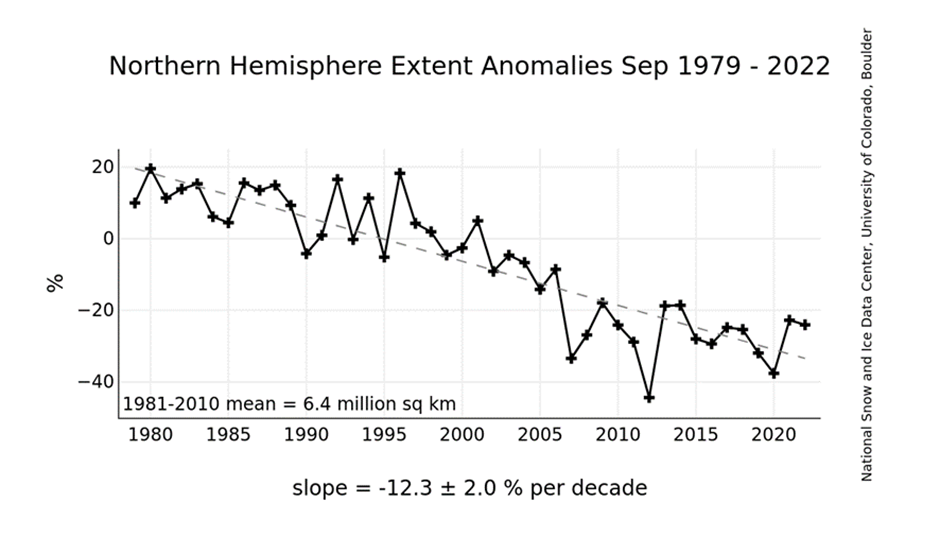
There’s no question about it, it’s clearly shrinking. Even more so than for the months of May. To finish, let’s choose 2 years that are representative of the long-term trend represented by the dotted line. September 1980 and September 2019, which are almost on the dotted line. The NSIDC maps show this,
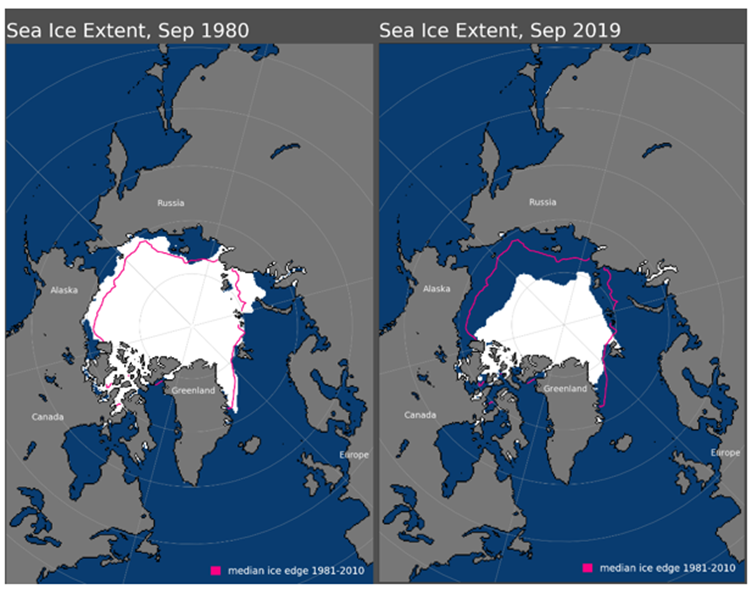
Here again, the clear downward trend in sea ice is clearly visible.
The bottom line is that these slides, which have been widely circulated on social networks, provide a good example of the logical fallacies commonly practised by climate sceptics. In reality, there are two defects in the merchandise. The first, known as cherry picking, consists of comparing judiciously chosen dates that seem to indicate a stable ice pack, while ignoring all the other dates that show a real decrease in the ice pack. The second trap is to choose a type of observation that is not relevant. In our case, the choice of comparing the state of the ice pack in May rather than September does not give a true picture of the real change in the quantity of ice. In fact, the most relevant quantity would have been the concentration of ice rather than the presence of ice. These examples show just how careful we need to be when manipulating climate data in the absence of an expert eye.
53. Brest tide gauge (2:08:52)
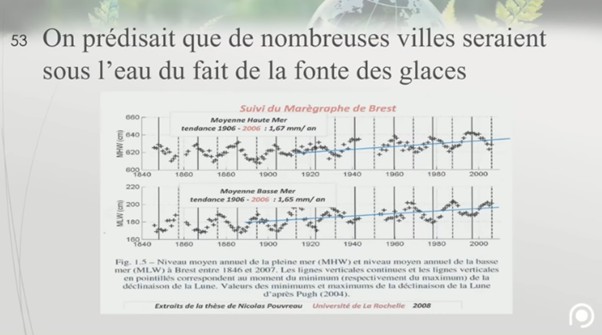
“The water level is slowly rising at a rate of 16 cm per century. There’s really nothing to worry about. There’s no problem at all. And it will go back down when the climate cools down (sic). There’s no problem, but the models continue to predict metres and metres of increase and drowned cities” (2:09:16)
The image appears to be taken from Nicolas Pouvreau’s thesis. “Three hundred years of tide gauge measurements in France: tools, methods and trends in sea level components in the port of Brest”. Climatology. University of La Rochelle, 2008.
Sea levels have been rising gradually since the 19th century, after remaining stable for almost 3,500 years. It is therefore important to specify the period over which its rise is determined. In the figure in the presentation, the rate of rise is evaluated over a century and is 16.5 cm per century. In 2020, this rate is estimated at 4 mm/year, or 40 cm per century. To determine this rate, it is important to take measurements at various points around the globe, because the values from individual tide gauges are affected by effects such as the vertical movement of the ground. The rate shown in the figure therefore greatly underestimates the true rise in sea level. The latest observations of the melting of the Antarctic ice cap have raised fears of an even more rapid rise than predicted.
A rise in sea level of several metres by 2300 is therefore, alas, not a fiction, but a reality that is solidly backed up by observations. In France, over 250,000 people will eventually have to leave coastal areas. On a global scale, more than a billion people will be affected. Poor regions like Bangladesh will be particularly hard hit. So there is a huge climate justice issue at stake.
The linked map shows the extent of flooded areas as a function of sea level.
Finally, will sea levels fall back, as predicted, if the climate cools? Yes, of course it will. But because of the inertia of the climate system and the long lifespan of greenhouse gases in the atmosphere, this fall will be slow, very slow. Even if mankind stopped emitting greenhouse gases altogether today, it would take well over a millennium to return to climatic conditions comparable to those that prevailed in the 1950s. It will take even longer to return to the same sea level.
54. No climate emergency (2:09:45)
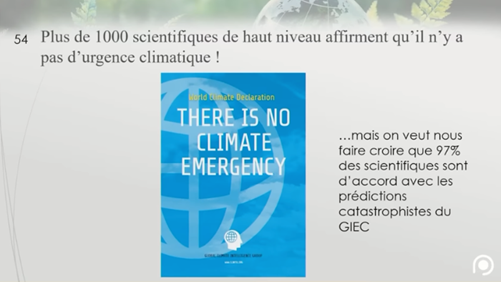
“Over a thousand renowned scientists, Nobel Prize winners and academics have signed a manifesto saying that there is no climate emergency. All this is deceiving us. And you don’t hear about it because we’ve been banned from Youtube. On Google, we’re doing everything we can to make sure it doesn’t appear.”
First of all, AFP has done an excellent job of dissecting all the problems posed by this appeal in an article – in French.
It should also be noted that the “There is no climate emergency” report is at the top of the search results (no. 1) on Google when you type “there is no climate emergency” or other search terms. So it’s completely wrong to suggest that the report has been removed from Google.
Etienne Vernaz raises a crucial point about scientific authority. A report signed by over a thousand scientists must carry an important, undeniable message, right? But what’s the reality?
Let’s first examine the signatories. There are currently over 1,100, including Etienne Vernaz. Among them is one (not “several”) Nobel laureate, Ivar Giaever, recognized for his work on semiconductors. What is his expertise on climate issues?
The list of signatories also includes academics, engineers, and individuals without doctorates. There are physicists, but also doctors, numerous geologists, journalists, and ultimately very few scientists working directly on climate-related issues. What credibility can be given to this document when compared to IPCC reports, each of which is based on over 10,000 climate-related scientific publications, thoroughly summarizing the current state of knowledge?
Finally, what is the authorizing body behind this report? It is CLINTEL (Climate Intelligence), a Dutch foundation that works in partnership with think tanks such as Friends of Science, which are primarily funded by the oil and gas industries. These think tanks, particularly active on the global political stage, advocate a worldview in which humans are not responsible for global warming. Unsurprisingly, several signatories of the report (especially many geologists) have ties to extractive industries. In this context, can we still trust the message of this report if there are so many conflicts of interest?
Contrary to what Etienne Vernaz claims, the Earth is not warming “gently”: the warming is very rapid and unprecedented in human history, and it is accelerating. A better image would be that of a gradually rising fever, and just like for the human body, an increase of 1°C (and even more so 5°C) is neither insignificant nor good news. 5°C is what separates us from the last ice age, a time when the ocean was 120 meters lower than today. So, warming is not good news, even if some beneficial effects are expected. What is certain is that “the negative impacts of global warming on agriculture, health, and the environment far outweigh any positive points.”
57.
Resist intimidation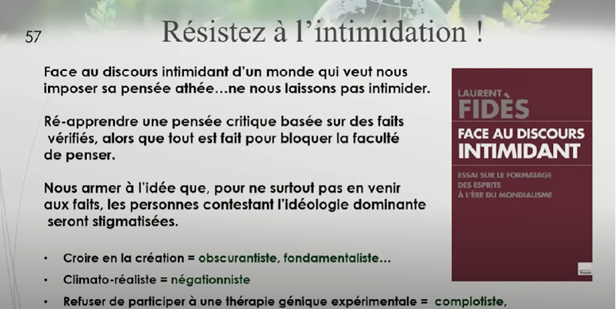
Contrary to what this slide suggests, there are many Christians who are also scientists, including many climate scientists such as Katharine Hayhoe, an American evangelical, and one of the first COP co-presidents, John Houghton, who clearly displayed his evangelical faith (the 2021 IPCC report is dedicated to him, as this article in Christianity Today reminds us).
These Christians, including ourselves, do not at all share Etienne Vernaz’s opinions. We are not atheists, and it’s precisely because we are Christians that we work to raise awareness about global warming and to change our lifestyles. We are motivated by love for our neighbors, our children, our grandchildren, and ourselves; and by obedience and love for God.
Many books offer testimonies from contemporary Christian scientists on the link between science and their faith, see for example J. Berry et al., Real Science, Real Faith (Monarch Books, 1991) or D. Haarsma, Delight in Creation: Scientists Share Their Work with the Church (Center for Excellence in Preaching, 2012).
These testimonies reveal a harmony between scientific practice and a living faith. Science appears as a tool that allows them to explore the world, to discover the laws that govern it, and to recognize the power of God’s creative hand. We are therefore not in conflict or confrontation, much less in an “anti-God thought.” On the contrary, we are in the realm of harmony and (re)cognition.
What is problematic in Etienne Vernaz’s discourse is precisely this insistence on the opposition between science, synonymous with evil, and the will of God. This divisive vision prevents any deeper reflection, such as that advocated by the Protestant historian and sociologist Jacques Ellul [J. Ellul, Le bluff technologique, Fayard, 2012], who was able to highlight the ambivalent nature of scientific progress and science: neither good nor bad, and even less neutral. If the applications of science turn against the Creator, it is primarily because we live in a fallen world and are under the sway of sin.
Finally, this slide talks about the proposal to “Relearn critical thinking through verified facts (…)”, with which we obviously agree. The scientific approach is based on a generally critical questioning of the state of knowledge, in order to “move things forward.” But it does not seem that Etienne Vernaz himself practices what he preaches.
2. Transcription of part of the speech
(from 2:06:43 to 2:11:57)
Discussion after the sermon
2:44:35 “There are no experts in the IPCC”.
It’s false. The individuals who write the IPCC reports are experts who, at the request of the UN, synthesize knowledge on climate science. We know some of them personally. IPCC reports aren’t penned by inefficient UN desk clerks; they’re written by scientists.
Misinformation Regarding Climate Models and Publications
2:45:00 “These experts only extract what interests them, what supports their propaganda. There are 50 models, and they extract the one that scares people…”
Having contributed to one of these panels (the Climate Model Intercomparison Project, CMIP6) which provides the data feeding the models used to build IPCC scenarios, Thierry Dudok de Wit (one of the contributors to this document) can say that this kind of unfounded assertion is completely false. “On the contrary, I was impressed by the quality of the work accomplished and by the modelers’ willingness to stick to the facts, without seeking to favor any particular model. And the ‘Working Group 1’ report does not shy away from commenting on models whose behavior deviates from the rest.”
2:46:00 “I have a friend at the Institute of Earth Physics who managed to get a publication through showing that climate change is linked to the sun. And by accident, I’d say, the publication came out in this major journal and was retracted a few months later. And he asked me why, you had accepted it, there were reviewers who had accepted it. Why don’t you see it anymore? And the journal editor’s response, who had received political threats, was: we didn’t give it to the right reviewer, we gave it to scientists instead of politicians. That’s the real answer. And so they eliminated it because it doesn’t align with the prevailing dogma.”
This affair, mentioned by Etienne Vernaz, caused a stir in 2009; it was widely commented on by the scientific community. It concerns not one but several articles by Vincent Courtillot and his team from the Institut de Physique du Globe de Paris. Vincent Courtillot is a geophysicist recognized for his work on the causes of dinosaur extinction. Towards the end of his career, he co-authored a series of articles questioning the anthropogenic causes of global warming. Several climate scientists criticized these works, some of which were marred by glaring errors. It was therefore a priori difficult to publish them in a serious scientific journal, as these journals have every manuscript evaluated by one or more anonymous reviewers.
Despite these criticisms, several of these articles managed to appear in the scientific journal Earth and Planetary Science Letters, known for its rigor. However, it later emerged that during the same period, Vincent Courtillot or his colleagues were part of the journal’s editorial board. In this capacity, they had entrusted the review of their team’s manuscripts to scientists of their choosing, in blatant violation of the code of ethics which requires an independent and anonymous editorial process (see for example this article and this one).
This affair led to a short article in the international journal Nature. It experienced various twists and turns, including the journal’s complacent handling of an error highlighted by scientists in one of the manuscripts (see this article). Following these accusations of fraud, the journal’s editorial board was completely renewed, and the publication—in that same journal—of climate articles co-signed by Vincent Courtillot ceased.
Thus, contrary to Etienne Vernaz’s assertion, the so-called victim of political pressure is, on the contrary, a person accused of having violated the rules of scientific ethics. Reversing the situation in this way to turn it to one’s advantage, by obscuring a large part of the facts, is unacceptable.
The Sun’s Role in Climate Change
As for the presumed role of solar variability in global warming observed since the 20th century, it’s a recurrent argument put forth by climate skeptics (see for example this article). The hypothesis essentially relies on observed correlations between the level of solar activity and certain observations on Earth. However, the existence of such correlations proves nothing without a scientific explanation that can then be validated or refuted by facts. According to the latest IPCC report, the Sun’s contribution to current warming is not zero but remains negligible compared to the anthropogenic contribution.
For a more in-depth analysis of the Sun’s role, see this study coordinated by Thierry Dudok de Wit, or this article published in Pour la Science (2016) and in The Conversation (2018). Also, see this conference by Antoine Bret.
